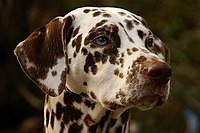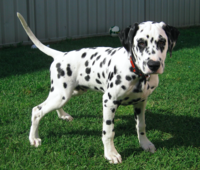John K. Rosembert
 Dalmatians are one of the oldest dog breeds known to man, although their exact origins are somewhat shrouded. The earliest recorded history of the breed places them in regions of Asia and Europe, particularly in Dalmatia, and it’s from here that the breed takes its name.
Dalmatians are one of the oldest dog breeds known to man, although their exact origins are somewhat shrouded. The earliest recorded history of the breed places them in regions of Asia and Europe, particularly in Dalmatia, and it’s from here that the breed takes its name.
Historically, Dalmatians have been known as coaching dogs, running around and beneath carriages, following their master’s travels. They are also known as the fireman’s friend, and once traveled along on runs in the days of the horse-pulled fire wagon. Dalmatians are a large, strong, muscular dog. The skull is about as wide as it is long, and flat on the top. The muzzle is about the same length as the top of the skull. The stop is moderate but well defined. The nose can be black, brown (liver), blue or a dark gray that looks like black. The teeth meet in a scissors bite. The medium-sized round eyes are brown, blue or a combination of both. The ears are set high, hanging down, gradually tapering to a rounded tip. The chest is deep. The base of the tail is level with the topline and tapers to the tip. The feet are round with arched toes. Toenails are white and/or black in black-spotted dogs and brown and/or white in liver-spotted dogs. The short coat has fine dense hairs. The symmetrical coat is predominantly white with clearly defined round spots. The spots can be black or brown (liver) which are the preferred colors in the show ring, but can also be, lemon, dark blue, tricolored, brindled, solid white or sable. Not all of these colors are accepted into the show ring, but they do occur in the breed. The more defined and well distributed the markings are, the more valued the dog is to the show ring. Puppies are born completely white and the spots develop later.
They are highly energetic, playful and sensitive dogs. They are loyal to their family and good with children, although some Dalmatian experts caution that the breed may be too energetic for very small children. These dogs are intelligent, can be well trained and make good watchdogs. Some Dalmatians can be reserved with strangers and aggressive toward other dogs; others are timid if they are not well socialized, and yet others can be high-strung. These dogs are known for having especially good “memories” and are said to recall any mistreatment for years.
Like other breeds, Dalmatians display a propensity towards certain health problems specific to their breed,
Such as:
- Deafness
A genetic predisposition for deafness is a serious health problem for Dalmatians; American Dalmatians exhibit a prevalence for bilateral congenital sensoneural deafness of 8%, (for which there is no possible treatment), compared with 5.3% for the UK population. Deafness was not recognized by early breeders, so the breed was thought to be unintelligent. Many breeders, when hearing testing started to become the norm, were amazed to discover that they had uni hearing dogs. Even after recognizing the problem as a genetic fault, breeders did not understand the dogs’ nature, and deafness in Dalmatians continues to be a frequent problem. - Dalmatian-Pointer Backcross Project
Hyperuricemia in Dalmatians (as in all breeds) is inherited, but unlike other breeds, the “normal” gene for a uric acid transporter that allows for uric acid to enter liver cells and be subsequently broken down is not present in the breed’s gene pool. Therefore, there is no possibility of eliminating hyperuricemia among pure-bred Dalmatians. The only possible solution to this problem must then be crossing Dalmatians with other breeds to reintroduce the “normal” uric acid transporter gene. This led to the foundation of the Dalmatian-Pointer Backcross Project, which aims to reintroduce the normal uric acid transporter gene into the Dalmatian breed. - Hyperuricemia
Dalmatians, like humans, can suffer from hyperuricemia, Dalmatians’ livers have trouble breaking down uric acid, which can build up in the blood serum (hyperuricemia) causing gout. Uric acid can also be excreted in high concentration into the urine, causing kidney stones and bladder stones. These conditions are most likely to occur in middle-aged males. Males over 10 are prone to kidney stones and should have their calcium intake reduced or be given preventive medication. - Eye Problems
Not many things have as dramatic an impact on your dog’s quality of life as the proper functioning of his eyes. Unfortunately, Dalmatians can inherit or develop a number of different eye conditions, some of which may cause blindness if not treated right away, and most of which can be extremely painful!.
Sources:
https://en.wikipedia.org/wiki/Dalmatian_(dog)
https://www.dogbreedinfo.com/dalmatian.htm
Photo credit:

